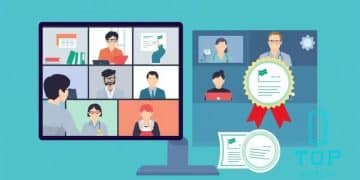Debt forgiveness programs expand for low-income graduates

Debt forgiveness programs expand for low-income graduates, allowing them to reduce or eliminate student loan burdens and enabling them to pursue careers without financial stress.
Debt forgiveness programs expand for low-income graduates, opening doors for many who feel trapped by student loan burdens. Have you ever wondered how these programs can change futures?
Understanding debt forgiveness programs
Understanding debt forgiveness programs is essential for low-income graduates who seek relief from student loans. These programs aim to alleviate financial stress and enable graduates to pursue their career goals without the burden of debt.
What Are Debt Forgiveness Programs?
Debt forgiveness programs are initiatives designed to reduce or eliminate the amount of student debt owed by borrowers. These programs can vary significantly depending on the institution, type of loans, and eligibility criteria.
Benefits of Debt Forgiveness
These programs provide many benefits, especially for low-income individuals. Below are some of the key advantages:
- Financial relief: Reducing the overall debt burden allows graduates to invest in their future.
- Improved mental health: Financial stress can lead to anxiety and depression, which these programs help alleviate.
- Encouragement to pursue low-paying jobs: Graduates can take careers in important fields like education or public service without worrying about loan repayments.
Many graduates find themselves overwhelmed by student loans, often delaying significant life decisions. Understanding debt forgiveness programs provides hope. Many programs offer various forgiveness options, and each has its own set of benefits.
Eligibility often hinges on employment in public service or non-profit sectors. Graduates may also need to demonstrate financial hardship. Thus, it is crucial to thoroughly understand each program and its requirements.
While navigating these options, graduates should calculate their potential forgiveness amounts based on their incomes and employment situations. This proactive approach can help them take advantage of the programs available.
Eligibility criteria for low-income graduates

Eligibility criteria for low-income graduates play a vital role in accessing debt forgiveness programs. Understanding these criteria can make a significant difference for those struggling to repay student loans.
Income Requirements
Most debt forgiveness programs set specific income limits. Graduates must demonstrate their income level to qualify for assistance. This ensures that help goes to those genuinely in need, emphasizing the importance of being aware of your income status.
Employment in Public Service
Many programs prioritize borrowers who work in public service jobs. Engaging in fields such as teaching, nursing, or law enforcement can enhance eligibility. It’s advantageous to explore positions that qualify, making a meaningful impact on society while gaining financial relief.
- Types of jobs that qualify: Teachers, nurses, and social workers.
- Non-profit sector roles: Many debt forgiveness programs consider work in non-profits as well.
- Community service jobs: Positions focusing on improving community welfare may also qualify.
As a low-income graduate, it’s essential to not only understand the eligibility criteria but also to take proactive steps. Gathering necessary documentation like income statements and employment records can streamline the application process. Connecting with resources available at your school or in your community can provide guidance and enhance your chances of success.
Staying informed about changes in eligibility requirements is crucial. Programs often update their criteria, and graduates should regularly check the eligibility guidelines for the debt forgiveness programs they are considering.
How to apply for debt forgiveness
Applying for debt forgiveness can seem overwhelming, but understanding the process makes it easier. Knowing what steps to take helps ensure that low-income graduates can access the support they need.
Gather Necessary Documentation
Before starting your application, collect all relevant documents. This includes proof of income, tax returns, and employment verification. Having everything organized will save time and reduce stress during the application process.
Research Available Programs
Different programs have various qualifications and benefits. Take time to research each option to find one that best suits your situation. Look for programs that cater specifically to low-income graduates and list out their specific eligibility requirements.
- Federal programs such as Public Service Loan Forgiveness.
- State-specific forgiveness options.
- Non-profit organization assistance.
Once you decide on a program, visit its official website for precise instructions on how to apply. Many programs provide step-by-step guides that clarify the process.
After gathering all materials, complete the application carefully. Pay attention to details, as any mistakes may lead to delays or denials. Consider seeking help from financial counselors or nonprofit organizations experienced in student loan assistance.
Lastly, after submitting your application, don’t forget to follow up. Maintain communication with the program administrators. Staying proactive can help address any questions or issues that may arise.
Success stories of graduates benefiting
Success stories of graduates benefiting from debt forgiveness programs highlight the positive impact these initiatives can have on individuals’ lives. These stories serve as inspiration for others who are struggling with student loans.
Real-Life Experiences
Many low-income graduates have shared their journeys of overcoming financial challenges thanks to debt forgiveness. For instance, consider a graduate who pursued a career in social work. With student loan debt weighing heavily on her shoulders, she qualified for a forgiveness program after a few years in public service.
Impact on Lives
Success stories often reveal how debt forgiveness can change lives. Here are a few key points:
- Career Choice: Graduates are free to choose careers in public service without fearing debt.
- Financial Stability: Many report increased financial security and peace of mind.
- Personal Growth: Graduates mention greater focus on their careers and personal aspirations.
Others have expressed how these programs allowed them to purchase homes or start families without the constant worry of student debt. The relief from monthly payments enables individuals to invest in their futures and contribute to their communities more meaningfully.
Such success stories emphasize the importance of taking action to apply for debt forgiveness. They illustrate that with perseverance and the right support, it is possible to turn a seemingly overwhelming situation into an opportunity for growth and advancement.
Future of student debt relief initiatives
The future of student debt relief initiatives holds promise as new programs are introduced and existing ones are refined. Many organizations and lawmakers are actively discussing ways to improve the system, making it more accessible for low-income graduates.
Emerging Trends
As awareness of student loan burdens grows, more innovative solutions are being explored. For instance, some proposals aim to simplify application processes, making it easier for borrowers to navigate the available options.
Potential Policy Changes
Future policies may include:
- Expanded eligibility: More graduates might qualify, even if they don’t currently meet strict income criteria.
- Increased funding: Governments could allocate more resources to support these initiatives, allowing more graduates to benefit.
- Partnerships with private organizations: Collaborations may help create additional support programs.
As the conversation around education financing evolves, the focus is shifting toward long-term sustainability. This involves not just alleviating current burdens but also preventing future graduates from facing similar issues.
Furthermore, technology is playing a critical role in shaping the future. Online resources and mobile applications may simplify information dissemination, providing real-time updates on eligibility and application processes. This accessibility ensures that graduates stay informed, increasing their chances of qualifying for relief.
Ultimately, the future of student debt relief initiatives is geared towards a more inclusive and streamlined process. Graduates can look forward to potential changes that offer not just hope, but real solutions that address their financial struggles.
FAQ – Frequently Asked Questions about Debt Forgiveness Programs
Who qualifies for debt forgiveness programs?
Low-income graduates working in public service or non-profit jobs typically qualify for debt forgiveness programs.
How do I apply for debt forgiveness?
Gather necessary documents like proof of income and employment verification, then follow the application instructions on the program’s official website.
What benefits do debt forgiveness programs offer?
These programs provide financial relief, allowing graduates to pursue fulfilling careers without the burden of student loans.
Is there a future for student debt relief initiatives?
Yes, ongoing discussions and innovations aim to expand access and improve the effectiveness of debt relief programs.





